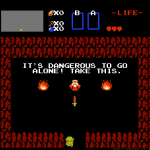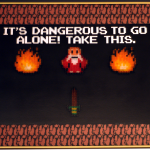Zelda Mural: The Adventure!
May 10, 2015I have recently finished a small Ode-to-Zelda techno-art project that involved some readily available construction materials like plastic moulding, foam board, and 3/16″ MDF board, as well as some less common parts like custom circuits, Pixel Blocks, and laser cut acrylic pieces. In the end, it took around 4 months to complete the project, but someone else who has access to more free time could complete it much sooner, and by not ordering parts from China on eBay (it usually took 4-5 weeks to arrive). It was very enjoyable and a good learning experience even though the result is not something I would want to sell, due to the lack of polish. Here is a photo of the scene in the game and the finished project:
It’s a representation of the first cave you come across in Nintendo’s pilot Legend of Zelda game. The scene illuminates with the flick of a switch on the left side of the frame. There is a flickering fire effect which is implemented via a couple of small circuits (5V) that are each driven by an Atmel ATTiny13-20PU 8-bit microcontroller and a series of low-power LED strips (12V). Since I wanted to drive the circuit with only one power supply, the project needed a small power regulation circuit to drive both loads.
Programming the flickering fire effect using the Atmel microcontroller can be tricky because it lacks a floating point unit and only has 1 KB of program space. This means that you can’t use decimal calculations lest the compiler pull in routines for floating point emulation, which result in a program too large to fit in the microcontroller. The solution was to employ a fancy sounding algorithm called a Linear Congruential Generator, which essentially provides the required randomness via a calculation that makes clever use of prime numbers. Early computers used this technique to achieve pseudo-random number generation at low computational cost.
The borders of the frame were printed using the graphics tiles copied from the game; the panels were sealed with rubberized paint spray and raised in a 3D effect using foam board, which itself has been painted and sealed for added strength and a semi-gloss, darker look. The letters have been laser cut from white acrylic using the font from the game; just a warning if you laser cut acrylic, it generates a nasty smell that is more than likely toxic, so get those laser cut pieces out in the open as soon as possible. I found the smell to dissipate after a few hours in the garage.
Categories: NES, Projects, Retro
No Comments »









No Responses to “Zelda Mural: The Adventure!”
Care to comment?